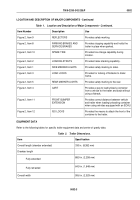TM-9-2330-342-23-P - Page 73 of 1348
FIELD MAINTENANCE
GENERAL INFORMATION
SCOPE
This manual is used for Field maintenance and troubleshooting of the Palletized Load System Trailer (PLST) M1076
A1. The PLST M1076 A1 provides a simple and effective way to load/unload a container from a vehicle to the trailer
and back without using a flatrack. This is done with the use of the cart that is located on the back of the trailer and
the Load Handling System (LHS) with either a Container Handling Unit (CHU) or Enhanced Container Handling Unit
(ECHU). The cart can be positioned in three different configurations (container mode, flatrack mode, or stored on
the bumper) depending on the mission. Flatracks and Engineering Mission Modules (EMM) can also be loaded/
unloaded onto the PLST M1076 A1 using the Load Handling System (LHS).
MAINTENANCE FORMS, RECORDS, AND REPORTS
Department of the Army forms and procedures used for equipment maintenance will be those prescribed by DA
PAM 750-8, The Army Maintenance Management System (TAMMS) Users Manual.
REPORTING EQUIPMENT IMPROVEMENT RECOMMENDATIONS (EIR)
If your PLST M1076 A1 needs improvement, let us know. Send us an EIR. You, the user, are the only one who can
tell us what you do not like about your equipment. Let us know why you do not like the design or performance.
All non-Aviation/Missile EIRs and PQDRs must be submitted through the Product Data Reporting and Evaluation
Program (PDREP) Web site. The PDREP site is: https://www.pdrep.csd.disa.mil/.
If you do not have Internet access, you may submit your information using an SF 368 (Product Quality Deficiency
Report). You can send your SF 368 using email, regular mail, or fax using the addresses/fax numbers specified in
DA PAM 750-8, The Army Maintenance Management System (TAMMS) Users Manual. We will send you a reply.
CORROSION PREVENTION AND CONTROL (CPC)
Corrosion Prevention and Control (CPC) of Army materiel is a continuing concern. It is important that any corrosion
problems with this item be reported so that the problem can be corrected and improvements can be made to prevent
the problem in future items.
Corrosion specifically occurs with metals. It is an electrochemical process that causes the degradation of metals. It
is commonly caused by exposure to moisture, acids, bases, or salts. An example is the rusting of iron. Corrosion
damage in metals can be seen, depending on the metal, as tarnishing, pitting, fogging, surface residue, and/or
cracking.
Plastics, composites, and rubbers can also degrade. Degradation is caused by thermal (heat), oxidation (oxygen),
solvation (solvents), or photolytic (light, typically UV) processes. The most common exposures are excessive heat
or light. Damage from these processes will appear as cracking, softening, swelling, and/or breaking.
SF Form 368, Product Quality Deficiency Report should be submitted to the address specified in DA PAM 750-8,
The Army Maintenance Management System (TAMMS) Users Manual.
DESTRUCTION OF ARMY MATERIEL TO PREVENT ENEMY USE
Command decision, according to the tactical situation, will determine when the destruction of the equipment will be
accomplished. A destruction plan will be prepared by the using organization unless one has been prepared by a
higher authority. Refer to TM 750-244-6 (WP
0190), Procedures for Destruction of Tank Automotive Equipment to
Prevent Enemy Use, for general destruction procedures.
TM 9-2330-342-23&P
0001
0001-1
Back to Top




















